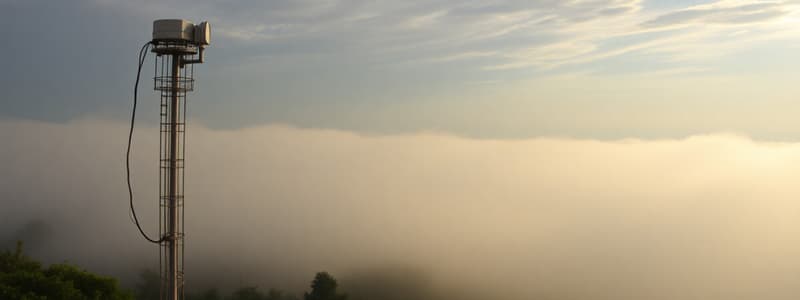Podcast
Questions and Answers
Which of the following locations is NOT typically used for weather monitoring stations?
Which of the following locations is NOT typically used for weather monitoring stations?
- Rural farms (correct)
- High hills
- Major roads and bridges
- Residential areas
What is the primary reason airplanes ascend to the stratosphere shortly after takeoff?
What is the primary reason airplanes ascend to the stratosphere shortly after takeoff?
- To maintain a higher speed
- To reduce air traffic congestion
- To avoid extreme weather conditions (correct)
- To optimize fuel consumption
Which factor is NOT associated with the formation of radiation fog?
Which factor is NOT associated with the formation of radiation fog?
- Gentle winds
- Clear skies
- Heavy rainfall (correct)
- High humidity
What phenomenon results from a combination of fog and pollutants?
What phenomenon results from a combination of fog and pollutants?
Which of the following best describes the impact of Earth's spherical shape on climate?
Which of the following best describes the impact of Earth's spherical shape on climate?
What is the primary reason for the temperature increase in the stratosphere?
What is the primary reason for the temperature increase in the stratosphere?
At what approximate rate does temperature decrease in the troposphere with height?
At what approximate rate does temperature decrease in the troposphere with height?
Which layer of the atmosphere is the coldest?
Which layer of the atmosphere is the coldest?
Which instrument is used to measure air pressure?
Which instrument is used to measure air pressure?
What defines weather in contrast to climate?
What defines weather in contrast to climate?
What is a primary characteristic of thermosphere?
What is a primary characteristic of thermosphere?
What is one of the social impacts of extreme weather?
What is one of the social impacts of extreme weather?
What element is measured in PM10/PM2.5?
What element is measured in PM10/PM2.5?
Flashcards
What is the atmosphere?
What is the atmosphere?
The layer of gases surrounding Earth, extending about 1,000 kilometers.
Describe the troposphere.
Describe the troposphere.
The lowest layer of the atmosphere, where weather occurs. Temperature decreases with height due to less air molecules.
What is the tropopause?
What is the tropopause?
The boundary between the troposphere and stratosphere. It's like a buffer zone.
Define weather.
Define weather.
Signup and view all the flashcards
What are the key features of a thunderstorm?
What are the key features of a thunderstorm?
Signup and view all the flashcards
What is convection?
What is convection?
Signup and view all the flashcards
What is extreme weather?
What is extreme weather?
Signup and view all the flashcards
What is precipitation?
What is precipitation?
Signup and view all the flashcards
Pressure Gradient Force
Pressure Gradient Force
Signup and view all the flashcards
Coriolis Force
Coriolis Force
Signup and view all the flashcards
Fog
Fog
Signup and view all the flashcards
Radiation Fog
Radiation Fog
Signup and view all the flashcards
Smog
Smog
Signup and view all the flashcards
Study Notes
The Atmosphere
- Definition: A layer of gas surrounding Earth, approximately 1,000 kilometers thick.
- Layers: Exosphere, Thermosphere, Mesosphere, Stratosphere, Troposphere
- Temperature Trends:
- Troposphere: Decreases with height, approximately 6°C per 1000 meters.
- Stratosphere: Increases due to ozone absorbing UV radiation.
- Mesosphere: Decreases, the coldest layer.
- Thermosphere: Increases, the warmest layer.
- Exosphere: Void of air molecules.
- Tropopause: Boundary between the troposphere and stratosphere (debated as part of atmosphere).
- Reasons for temperature change: Fewer air molecules in higher altitudes, ozone absorbing UV radiation, and the efficient absorption of solar radiation by N2, O2, and O.
Weather
- Definition: The condition of the atmosphere at a specific place and time.
- Characteristics: Variability in weather elements.
- Weather Elements:
- Temperature (°C or °F)
- Precipitation (mm or cm)
- Humidity (%)
- Air Pressure (millibars)
- Wind Speed (mph or kph)
- Wind Direction (compass directions)
- Cloud Cover (oktas)
- PM10/PM2.5
- UV
Weather Measurement
- Instruments: Thermometers, rain gauges, hygrometers, barometers, anemometers, wind vanes, wind socks, optical particle counters.
- Units of measurement: For each weather element.
- Stevenson Screen: Components and purpose of this screen for weather measurement.
Atmospheric Processes
- Convection currents
- Wind formation
- Precipitation formation
- Solar radiation effects on temperature at different latitudes
- Uneven heating of Earth's surface leading to weather formation
- Formation of rain and clouds
- Fog formation: Radiation fog and other conditions
Weather Phenomena and Extreme Weather
- Definition of extreme weather.
- Thunderstorms: Heavy rain, lightning, thunder.
- Differences between lightning, lightening, and thunder.
- Flooding and its impacts.
- Social, economic, and environmental impacts of extreme weather.
Weather Monitoring and Forecasting
- Weather monitoring stations: Ships, high hills, major roads/bridges, airports, residential/commercial areas.
- Weather balloons and satellites.
- Macao Meteorological and Geophysical Bureau (SMG).
Aviation and Weather
- Reasons for airplanes ascending to the stratosphere after takeoff.
- Avoiding extreme weather conditions in the troposphere.
Climate and Geography
- Relationship between latitude and temperature.
- Earth's spherical shape impact on solar radiation.
- Global distribution of rainforests along the equatorial low-pressure belt.
Atmospheric Dynamics
- Pressure gradient force
- Coriolis force: Wind deflection in Northern and Southern hemispheres.
- High and low-pressure systems.
- Formation of unstable weather.
Specific Weather Phenomena
- Fog: Definition, formation process (radiation fog), conditions and formation process, factors contributing to its formation (clear sky, gentle wind), and its disappearance process.
- Smog: Combination of fog and pollutants.
Global Weather Patterns
- Factors influencing global weather patterns.
- Equatorial low-air pressure belt and its effects.
Studying That Suits You
Use AI to generate personalized quizzes and flashcards to suit your learning preferences.



